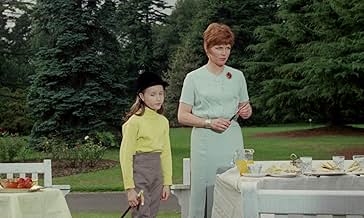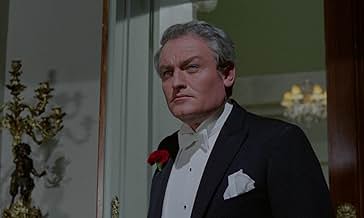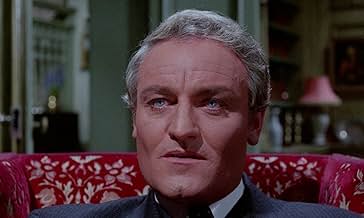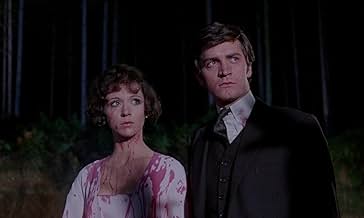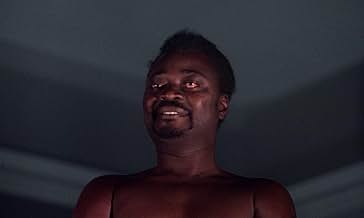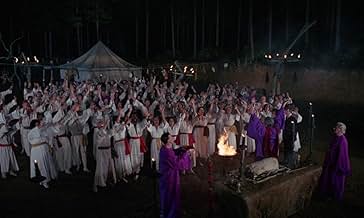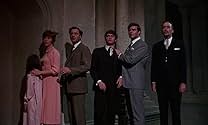Nike Arrighi
- Tanith Carlisle
- (as Niké Arrighi)
Yemi Goodman Ajibade
- African
- (uncredited)
Patrick Allen
- Rex Van Ryn
- (voice)
- (uncredited)
Liane Aukin
- Satanist
- (uncredited)
John Bown
- Receptionist
- (uncredited)
Peter Brace
- Satanist
- (uncredited)
John Falconer
- Satanist
- (uncredited)
Anne Godley
- Satanist
- (uncredited)
- Director
- Writers
- All cast & crew
- Production, box office & more at IMDbPro
Featured reviews
A classic, vintage horror, another classic from Hammer Horror.
Expect the usual Hammer attributes, terror, shock, scares, and a lot of mesmerism. It doesn't stint on the terror factor here, even now it packs a punch, with some sinister concepts.
It looks incredible, it's so well shot, with gorgeous sets and costumes, it is very well produced.
Of course Christopher Lee is the headline, and as always he doesn't disappoint, but he is well supported, Charles Gray is terrific, it's all about the eyes, great also to see Paul Eddington.
It's one of those films that time has been very kind to, it simply doesn't date.
Excellent, 8/10.
Expect the usual Hammer attributes, terror, shock, scares, and a lot of mesmerism. It doesn't stint on the terror factor here, even now it packs a punch, with some sinister concepts.
It looks incredible, it's so well shot, with gorgeous sets and costumes, it is very well produced.
Of course Christopher Lee is the headline, and as always he doesn't disappoint, but he is well supported, Charles Gray is terrific, it's all about the eyes, great also to see Paul Eddington.
It's one of those films that time has been very kind to, it simply doesn't date.
Excellent, 8/10.
Last night I saw this film for the first time in 35 years. Time has been kinder to it than it has to many Hammer films, but this one is less driven by effects and make-up and more by dialog.
That's all for the better because once again, when need be, Hammer fails in the effects department. I had forgotten how the theater went wild in 1968 while looking at the cheap tarantula effect - was it growing or not, the perspective changed constantly.
Some of the effects are of the "stop the camera" variety, no more convincing here than on "Lost In Space." But still, it is the performances, situations and the dialog that engage us. Christopher Lee, who brought the project to Hammer, seems to be enjoying himself as the Duc de Richleau, finally getting to play a hero. His longtime friend Rex, played by Leon Greene (but voiced by Patrick Allen) is a real stalwart guy, given to punching out windshields when necessary, climbing into car trunks, and throwing a crucifix from a running board to eliminate the specter of the devil himself.
The best scene has Lee and company in a circle in which to protect themselves from the evils sent by Mocata, played by Charles Gray with a suaveness that matches the twinkle of his blue eyes. Mocata tries every trick in the book, including trying to make it appear that the daughter of the household is being threatened by the tarantula, as well as an Angel of Death on horseback (it is a large room). Meanwhile, outside, Rex has a potential female victim tied up for her own good, she later becomes a medium when the previously "threatened" little girl is kidnapped - to take the place of the medium on the sacrificial altar!
Nike Arrighi plays the "medium" - a young woman who was to have been re-baptized as a servant of the devil, but whose life now hangs in the balance between the black magic of Mocata, or the efforts of the Duc de Richleau, and she has more talent than most of the Hammer actresses of the period. The Duc's friend Rex falls for her, but is hard pressed to keep up with the spells of Mocata, who will stop at nothing to reclaim his servant.
What really helps the film is a great sense of period - somewhere midway between the two world wars. The props (especially the vehicles) and costumes are quite right, and the landscapes are far more diverse than the usual Bray Studios trappings. There's no doubt that the team sought to make this one special and shoot on some real locations - and it's perhaps here rather than in the effects that the budget was concentrated. All in all, despite some shortcomings, a very enjoyable Hammer film, a solid Richard Matheson script from a superior Dennis Wheatley novel makes for exciting viewing, far superior to the previous Satanic Hammer film "The Witches" (aka "The Devil's Bride") and equal to the later adaptation of Wheatley's own "To the Devil A Daughter" - the last Hammer film which may have its less than sterling reputation for that measure alone.
That's all for the better because once again, when need be, Hammer fails in the effects department. I had forgotten how the theater went wild in 1968 while looking at the cheap tarantula effect - was it growing or not, the perspective changed constantly.
Some of the effects are of the "stop the camera" variety, no more convincing here than on "Lost In Space." But still, it is the performances, situations and the dialog that engage us. Christopher Lee, who brought the project to Hammer, seems to be enjoying himself as the Duc de Richleau, finally getting to play a hero. His longtime friend Rex, played by Leon Greene (but voiced by Patrick Allen) is a real stalwart guy, given to punching out windshields when necessary, climbing into car trunks, and throwing a crucifix from a running board to eliminate the specter of the devil himself.
The best scene has Lee and company in a circle in which to protect themselves from the evils sent by Mocata, played by Charles Gray with a suaveness that matches the twinkle of his blue eyes. Mocata tries every trick in the book, including trying to make it appear that the daughter of the household is being threatened by the tarantula, as well as an Angel of Death on horseback (it is a large room). Meanwhile, outside, Rex has a potential female victim tied up for her own good, she later becomes a medium when the previously "threatened" little girl is kidnapped - to take the place of the medium on the sacrificial altar!
Nike Arrighi plays the "medium" - a young woman who was to have been re-baptized as a servant of the devil, but whose life now hangs in the balance between the black magic of Mocata, or the efforts of the Duc de Richleau, and she has more talent than most of the Hammer actresses of the period. The Duc's friend Rex falls for her, but is hard pressed to keep up with the spells of Mocata, who will stop at nothing to reclaim his servant.
What really helps the film is a great sense of period - somewhere midway between the two world wars. The props (especially the vehicles) and costumes are quite right, and the landscapes are far more diverse than the usual Bray Studios trappings. There's no doubt that the team sought to make this one special and shoot on some real locations - and it's perhaps here rather than in the effects that the budget was concentrated. All in all, despite some shortcomings, a very enjoyable Hammer film, a solid Richard Matheson script from a superior Dennis Wheatley novel makes for exciting viewing, far superior to the previous Satanic Hammer film "The Witches" (aka "The Devil's Bride") and equal to the later adaptation of Wheatley's own "To the Devil A Daughter" - the last Hammer film which may have its less than sterling reputation for that measure alone.
Heading the great Hammer Horror Revival was Terence Fisher, the director whose adaptations of the Universal horror classics, The Curse Of Frankenstein (1957), The Horror of Dracula (1958) and The Mummy (1959) sealed the studio's fate as the leading producer of British gothic horror for almost 20 years. Throughout the 60s, while half of Hammer's output were rather silly adventure yarns (The Viking Queen, The Vengeance Of She) and lazy exercises in generic conventions (Curse Of The Mummy's Tomb, The Old Dark House), Fisher created more adult-oriented horror - psychological, almost Freudian horror (The Gorgon, Frankenstein Created Woman), drawing on the sexual conflicts of the repressive English social climate starting to fray at the seams. Fisher's final film, Frankenstein And The Monster From Hell (1973) is British horror at its bleakest - a deeply disturbing and amoral portrait of amorality in the figure of Fisher's greatest creation, Baron Frankenstein as essayed by Hammer icon Peter Cushing. Over twenty years after his death he is still regarded as Britain's greatest ever horror director.
Fisher began work on The Devil Rides Out, the first of three Dennis Wheatley adaptations, in the summer of 1967. From the opening credits, an indecipherable mass of occult symbols appearing out of a red mist punctuated with James Bernard's ominous orchestral score, screenwriter Richard Matheson (I Am Legend author and scriptwriter of Roger Corman's Edgar Allen Poe series) sharpens Crowley's prose to create a frighteningly real world of dark forces at work beneath the genteel surface of the English aristocracy. At a reunion of old friends at a country estate, occult expert the Duc de Richelieu (Christopher Lee) and his well-meaning but impulsive lantern-jawed sidekick Rex (Leon Greene) discover their young comrade Simon (Patrick Mower) has become involved in `astrological society', a thinly-veiled satanic cult lead by the charismatic Mocata (Charles Gray). Richelieu and Rex kidnap Simon to prevent his Devil's baptism, but he escapes. Mocata then uses Richelieu's friends Richard (Yes Minister's Paul Eddington) and his family, and Tanith (Nike Arrighi), a young French beauty also marked for baptism, as bait to lure Richelieu to his destruction.
For a studio defined by its reworkings of Dracula and Frankenstein, Mocata is one of Hammer's most frightening monsters. Veteran Shakespearean actor Gray, best remembered these days as the Bond villain in Diamonds Are Forever (1971) and the narrator in The Rocky Horror Picture Show (1975), conveys the palpable menace from his cold, unflinching steel-gray eyes and his carefully modulated voice, a master of hypnosis and mind control no doubt based on real-life characters from Wheatley's days in British Intelligence (some say Mocata is smoother version of the `Great Beast', occultist Alistair Crowley, whom Wheatley was acquainted with). Matheson's script changes the Mocata character from a swarthy European figure of Word War 2-era intrigue into an English `gentleman', more forcefully underpinning the tension between England's exterior pastoral elegance and class respectability, and its repressed bacchanalian urges. Wheatley, a British author best known for his black magic tales and costume adventure stories, was an avid collector of occult esoterica and was reportedly delighted with the film, as Matheson's script had expanded on his own research his Black Magic rituals with an eye for detail, drawing on Crowley's writings as well as Sumerian and Egyptian legends, occult and pagan texts.
Of course the film's focus is on the imposing figure of the six foot four Christopher Lee, by 1967 a genre superstar having played Dracula, the Frankenstein monster, the Mummy, Rasputin, even Sherlock Holmes. Lee had in fact pressed Hammer to purchase the rights for Wheatley's novel, and was delighted to play a character on the side of `good' after a decade typecast as Dracula.
Hammer films are characterized by relatively low budgets, compensated by taut direction and expert characterization, and a winning combination of tight studio sets and English country exteriors. The Devil Rides Out utilizes its stagebound scenario to chilling effect: Simon's cold gray observatory turns malevolent purely by adding scratching noises from a cupboard. The budget only lets the film down in its two major setpieces; both the final sacrificial ceremony at Mocata's mansion and the Grand Sabbat, supposedly a grand ritual orgy for Simon and Tanith's intended baptism, veer toward poorly-staged pantomime. When Mocata invokes Satan (`The Goat of Mendes - the Devil himself!') at the Sabbat, the sight of a rather wretched figure with pin-on horns and raccoon eyes tends to blunt the scene's horrific implications. Indeed the film's scariest scene is set in an empty room; Richelieu, Rex and the family take refuge inside a chalk circle and are confronted by a series of apparitions conjured by Mocata. Again the scene is only marred by the final ghastly figure: a horsebound Angel of Death, whose mask drops to reveal a cheap-looking grinning plastic skull.
The Devil Rides Out was an artistic triumph but not a commercial success. Perhaps it was the unfamiliar tone of the film, or the fact Christopher Lee had his fangs filed down; two further Duc de Richelieu adventures starring Lee, Strange Conflict and Gateway To Hell were abandoned. Hammer's next venture after The Devil Rides Out, The Lost Continent (an ambitious reworking of Wheatley's Jules Verne style adventure novel Uncharted Seas) went wildly overbudget and Wheatley was not impressed, citing a number of plot changes by director Michael Carreras. The third Wheatley adaptation, a grotesque updating of To The Devil A Daughter with Richard Widmark and an embarrassed Christopher Lee, was Hammer's horror swansong in 1976, and the company sank soon after. Maybe it was the curse of Dennis Wheatley after all - still, for us horror iconoclasts, we still have The Devil Rides Out, a film that remains after 35 years one the finest examples of the gone but never to be forgotten house of Hammer.
Fisher began work on The Devil Rides Out, the first of three Dennis Wheatley adaptations, in the summer of 1967. From the opening credits, an indecipherable mass of occult symbols appearing out of a red mist punctuated with James Bernard's ominous orchestral score, screenwriter Richard Matheson (I Am Legend author and scriptwriter of Roger Corman's Edgar Allen Poe series) sharpens Crowley's prose to create a frighteningly real world of dark forces at work beneath the genteel surface of the English aristocracy. At a reunion of old friends at a country estate, occult expert the Duc de Richelieu (Christopher Lee) and his well-meaning but impulsive lantern-jawed sidekick Rex (Leon Greene) discover their young comrade Simon (Patrick Mower) has become involved in `astrological society', a thinly-veiled satanic cult lead by the charismatic Mocata (Charles Gray). Richelieu and Rex kidnap Simon to prevent his Devil's baptism, but he escapes. Mocata then uses Richelieu's friends Richard (Yes Minister's Paul Eddington) and his family, and Tanith (Nike Arrighi), a young French beauty also marked for baptism, as bait to lure Richelieu to his destruction.
For a studio defined by its reworkings of Dracula and Frankenstein, Mocata is one of Hammer's most frightening monsters. Veteran Shakespearean actor Gray, best remembered these days as the Bond villain in Diamonds Are Forever (1971) and the narrator in The Rocky Horror Picture Show (1975), conveys the palpable menace from his cold, unflinching steel-gray eyes and his carefully modulated voice, a master of hypnosis and mind control no doubt based on real-life characters from Wheatley's days in British Intelligence (some say Mocata is smoother version of the `Great Beast', occultist Alistair Crowley, whom Wheatley was acquainted with). Matheson's script changes the Mocata character from a swarthy European figure of Word War 2-era intrigue into an English `gentleman', more forcefully underpinning the tension between England's exterior pastoral elegance and class respectability, and its repressed bacchanalian urges. Wheatley, a British author best known for his black magic tales and costume adventure stories, was an avid collector of occult esoterica and was reportedly delighted with the film, as Matheson's script had expanded on his own research his Black Magic rituals with an eye for detail, drawing on Crowley's writings as well as Sumerian and Egyptian legends, occult and pagan texts.
Of course the film's focus is on the imposing figure of the six foot four Christopher Lee, by 1967 a genre superstar having played Dracula, the Frankenstein monster, the Mummy, Rasputin, even Sherlock Holmes. Lee had in fact pressed Hammer to purchase the rights for Wheatley's novel, and was delighted to play a character on the side of `good' after a decade typecast as Dracula.
Hammer films are characterized by relatively low budgets, compensated by taut direction and expert characterization, and a winning combination of tight studio sets and English country exteriors. The Devil Rides Out utilizes its stagebound scenario to chilling effect: Simon's cold gray observatory turns malevolent purely by adding scratching noises from a cupboard. The budget only lets the film down in its two major setpieces; both the final sacrificial ceremony at Mocata's mansion and the Grand Sabbat, supposedly a grand ritual orgy for Simon and Tanith's intended baptism, veer toward poorly-staged pantomime. When Mocata invokes Satan (`The Goat of Mendes - the Devil himself!') at the Sabbat, the sight of a rather wretched figure with pin-on horns and raccoon eyes tends to blunt the scene's horrific implications. Indeed the film's scariest scene is set in an empty room; Richelieu, Rex and the family take refuge inside a chalk circle and are confronted by a series of apparitions conjured by Mocata. Again the scene is only marred by the final ghastly figure: a horsebound Angel of Death, whose mask drops to reveal a cheap-looking grinning plastic skull.
The Devil Rides Out was an artistic triumph but not a commercial success. Perhaps it was the unfamiliar tone of the film, or the fact Christopher Lee had his fangs filed down; two further Duc de Richelieu adventures starring Lee, Strange Conflict and Gateway To Hell were abandoned. Hammer's next venture after The Devil Rides Out, The Lost Continent (an ambitious reworking of Wheatley's Jules Verne style adventure novel Uncharted Seas) went wildly overbudget and Wheatley was not impressed, citing a number of plot changes by director Michael Carreras. The third Wheatley adaptation, a grotesque updating of To The Devil A Daughter with Richard Widmark and an embarrassed Christopher Lee, was Hammer's horror swansong in 1976, and the company sank soon after. Maybe it was the curse of Dennis Wheatley after all - still, for us horror iconoclasts, we still have The Devil Rides Out, a film that remains after 35 years one the finest examples of the gone but never to be forgotten house of Hammer.
How on earth did it take me so long to see 'The Devil Rides Out' and to even hear of it? This is the sort of film that should have been seen by me years ago, being somebody who likes many of the Hammer Horror films and who has always loved Christopher Lee. It also had on board other much admired people and Hammer Horror regulars, namely Terence Fisher as director and James Bernard as composer. It was my dad who recommended it to me when we happened to be channel surfing and 'The Devil Rides Out' happened to be on.
After seeing 'The Devil Rides Out', my mind is still blown about how it took me so long to see it or even know of it. It is an absolute gem and is to me one of Hammer Horror's best, it is hardly surprising that it was Lee's (in a departure role at the time, having specialised as villains) favourite of theirs. It is still a very clever and genuinely unsettling film that has held up incredibly and surprisingly well, considering that there were films at the time from the genre and with a similar tone that come over as fairly cheesy now. To me there is nothing cheesy about 'The Devil Rides Out'. Also read the book since and this is a rare case of the film being better than the source material, leaner and creepier.
Sure, the special effects are not always great and a little wobbly such as the spider. Have though on reflection seen far worse-looking spiders in film and television, the notoriously awful one from the 'IT' mini-series anyone?
Otherwise there is very little to fault. Other than (some of) the effects 'The Devil Rides Out' is a good looking film, especially the eerie lighting in namely the Angel of Death, an effect that actually still looks scary, and and Ghost of Mendes sequences and the photography which is both sumptuous and menacing-looking. Bernard's score has a real ominous vibe throughout without being too intrusive or too loud, as does the sound quality. Especially the Angel of Death scene, audibly that was quite hair-raising stuff. Fisher directs intelligently and with a good feel for unnerving atmosphere.
Richard Matheson's script is pacey and always thought-provoking, with no signs of awkwardness or fat. The story never felt dull, even when it was not as horror-centric and had more talk, and the atmosphere at its best is shiver-inducing. The genuinely creepy Ghost of Mendes and Angel of Death scenes stand out (the latter is unforgettable), as does the very clever and unnerving climax that kept me in suspense.
Even when not playing a villain, Lee is still a very powerful presence and cuts a quite elegant figure. The other standout is Charles Gray, who was never this frightening before or since. The rest of the cast are all fine, but not quite in the same league as Lee and Gray.
In conclusion, devillishly good. No make that great. 9/10
After seeing 'The Devil Rides Out', my mind is still blown about how it took me so long to see it or even know of it. It is an absolute gem and is to me one of Hammer Horror's best, it is hardly surprising that it was Lee's (in a departure role at the time, having specialised as villains) favourite of theirs. It is still a very clever and genuinely unsettling film that has held up incredibly and surprisingly well, considering that there were films at the time from the genre and with a similar tone that come over as fairly cheesy now. To me there is nothing cheesy about 'The Devil Rides Out'. Also read the book since and this is a rare case of the film being better than the source material, leaner and creepier.
Sure, the special effects are not always great and a little wobbly such as the spider. Have though on reflection seen far worse-looking spiders in film and television, the notoriously awful one from the 'IT' mini-series anyone?
Otherwise there is very little to fault. Other than (some of) the effects 'The Devil Rides Out' is a good looking film, especially the eerie lighting in namely the Angel of Death, an effect that actually still looks scary, and and Ghost of Mendes sequences and the photography which is both sumptuous and menacing-looking. Bernard's score has a real ominous vibe throughout without being too intrusive or too loud, as does the sound quality. Especially the Angel of Death scene, audibly that was quite hair-raising stuff. Fisher directs intelligently and with a good feel for unnerving atmosphere.
Richard Matheson's script is pacey and always thought-provoking, with no signs of awkwardness or fat. The story never felt dull, even when it was not as horror-centric and had more talk, and the atmosphere at its best is shiver-inducing. The genuinely creepy Ghost of Mendes and Angel of Death scenes stand out (the latter is unforgettable), as does the very clever and unnerving climax that kept me in suspense.
Even when not playing a villain, Lee is still a very powerful presence and cuts a quite elegant figure. The other standout is Charles Gray, who was never this frightening before or since. The rest of the cast are all fine, but not quite in the same league as Lee and Gray.
In conclusion, devillishly good. No make that great. 9/10
Very cool Hammer film from the great Terence Fisher with Christopher Lee playing the good guy for a change. Lee plays the Duc de Richleau who, along with his friend Rex Van Ryn (Leon Greene), rescues a late friend's son and a young woman from a Satanic cult led by a powerful man named Mocata (Charles Gray). Now holed up at a country estate, de Richleau and Rex must fight off Mocata and the forces of evil.
One of my favorite Hammer films. The screenplay comes from Richard Matheson, adapted from a novel by Dennis Wheatley. Fisher's direction is terrific. The movie has a great 1920s period look and at times a very creepy atmosphere. The cast is excellent, with Lee giving one of his best performances. Charles Gray gives a subdued turn that makes him all the more menacing. I really like this one and rewatch it more than most Hammer movies I own. It's an exciting, enjoyable movie that will surely please Lee and Hammer fans.
One of my favorite Hammer films. The screenplay comes from Richard Matheson, adapted from a novel by Dennis Wheatley. Fisher's direction is terrific. The movie has a great 1920s period look and at times a very creepy atmosphere. The cast is excellent, with Lee giving one of his best performances. Charles Gray gives a subdued turn that makes him all the more menacing. I really like this one and rewatch it more than most Hammer movies I own. It's an exciting, enjoyable movie that will surely please Lee and Hammer fans.
Did you know
- TriviaThe film was made at Christopher Lee's insistence that Hammer do a movie based on a Wheatley fantasy novel.
- GoofsDuring the opening credits, a symbol is shown that is not Satanic, and it is also incorporated into the symbol on the priestly robes during the film. Inscribed within a Star of David, there is a six-winged seraph with the faces of a man, lion, ox and eagle based on the vision of Ezechiel. In Christian tradition, the four faces become associated with the four gospel writers: Matthew, Mark, Luke and John.
- Quotes
Marie Eaton: [to her servant about Mocata] Show him out!
Mocata: I'm leaving.
[walks towards door and stands behind Marie]
Mocata: *I* shall not be back... but something will.
[pauses menacingly]
Mocata: Tonight! Something will come for Simon and the girl!
[leaves]
- Alternate versionsThe 2012 UK Blu-ray Disc released by Studio Canal features digitally enhanced special effects. The makers of the Blu-ray claim to complete shots which had never been finished due to budget reasons:
- Matte shot of Simon's mansion with the Observatory dome has been replaced with a CGI background.
- During the ritual at the climax of the movie a lighting has been replaced with a new CGI lightning.
- Spider sequence: Shadow for the spider has been added, some matte shots enhanced, and digital smoke added when the spider is sprayed with holy water.
- The Angel of Death sequence: A light effect is illuminating the door to cover the poor original optical effect when the angel rides through the door. The close up of the Angel of Death has a new background with flames as the original intended shot was never finished.
- The matte shots of Charley Grey's death in the fire have been digitally corrected as there were optical errors in the layers of the matte shots.
- Several other matte shots have been improved by removing matte lines.
- ConnectionsFeatured in Iron Maiden: The Number of the Beast (1982)
Details
- Release date
- Country of origin
- Language
- Also known as
- La poo poo
- Filming locations
- Production companies
- See more company credits at IMDbPro
- Runtime1 hour 36 minutes
- Aspect ratio
- 1.66 : 1
Contribute to this page
Suggest an edit or add missing content



